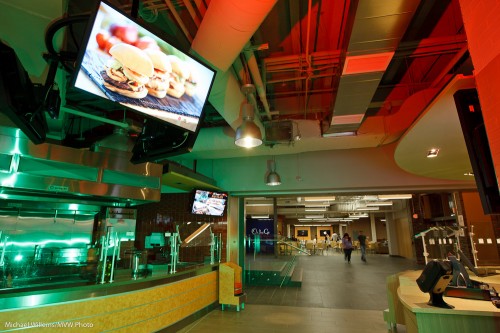Often, as a photographer I have to do the impossible.
That is, of course, an overstatement. But there is a core of truth in it: photography is problem-solving.
The other night I shot an excellent Digital Signage installation. Innovative screens, powered by EnQii software, in a self-service restaurant.
The problem is: the screens are bright and need to be seen. And the restaurant is dark compared to the screens. Expose for the screens and the restaurant is dark. Expose for the restaurant and the screens overexpose.
There are three potential solutions:
- Turn down the screens. Not an option here…
- Light the restaurant with flashes. Lot of work, and not practical in a working restaurant.
- Shoot RAW and bring bright and dark together in post-processing.
I used a combination of 2 and 3.
More 3 than 2 in this shot:
And more 2 than 3 in this shot – with coloured Honl gels on my speedlites:
As you see, an impossible-to-shoot scene is possible.
- Do a test shot or two, in some automatic mode. Ensure you shoot RAW.
- Ensure you use a tripod if necessary (and it will be).
- Now first, expose for the screens. Expose to the right, but do not lose detail. Use the histogram and the “blinkies” to gauge this.
- Use a tripod if necessary.
- Then add light if necessary.
- Then in post-production, use “recovery” to decrease brightness in the screens, and “shadows” to increase brightness in the darker areas.
Try it – it is really not all that difficult!



There is a fourth solution if you have a tripod (and are allowed to use it), which you have in your list twice. Put the camera on the tripod, shoot JPEG or RAW, set the camera to take 3 or 5 exposures, one at “correct” exposure, the rest over and under exposed. Use HDR techniques but do not produce the “luminous look”. You can do that with HDR software or with Photoshop, or Photoshop Elements, or even GIMP if you want a free solution.
If you bracket and shoot in RAW, you can process the over/under exposed files an additional 3 or 4 EV from the exposure which will provide more dynamic range than the scene has in almost all cases.
Very true.
The reason I did my HDR in the camera, however (because that is what my technique amounts to!) is twofold. 1. Simpler. And 2. There are some moving objects in the images, and I wanted to maximize those, not exclude them.
Michael
Is HDR a viable solution to this problem? How difficult would it be to get a satisfactory outcome merging a couple of different exposures?
I wish I had refreshed the page before I posted my comment. No need to answer a duplicate question!